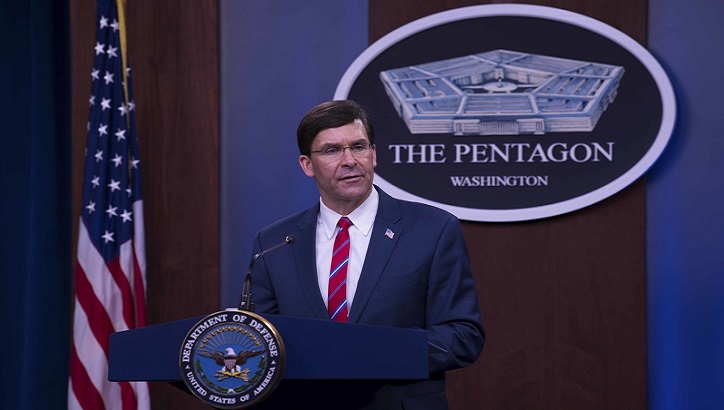
DoD aims to fill medical gaps with military while states, cities ramp up

Defense Secretary Dr. Mark T. Esper speaks to reporters during a news conference at the Pentagon to discuss the department's efforts in response to the COVID-19 pandemic, March 23, 2020. (DoD photo by Army Staff Sgt. Brandy Nicole Mejia)
The Navy hospital ship USNS Mercy will go to Los Angeles to help relieve pressure on hospitals there so they can focus more on COVID-19 patients, Defense Secretary Dr. Mark T. Esper said.
"We're working closely with [the Federal Emergency Management Agency] to set the conditions for the ship's arrival later this week, so that she can start receiving non-COVID-19 medical patients to free up bed space in some of LA's most heavily stressed hospitals," Esper said during a news conference at the Pentagon.
Esper said in the next couple of weeks, the USNS Comfort, currently at Norfolk, Virginia, will head to New York City for the same purpose. The crew and staff there, he said, are preparing for that mission.
Five military field hospitals and expeditionary medical units are on "prepare to deploy" orders, Esper said, and are expected to mobilize this week to various parts of the country. Where those units go, he added, will be based on discussions with FEMA.
"Right now, I anticipate sending a hospital to Seattle and a hospital [to] New York City," Esper said. "Beyond that, once that's confirmed, we will look at sending to other places and, as necessary, we will continue to alert units to prepare to deploy and then deploy them as appropriate."
The hospital ships, military field hospitals and expeditionary medical units must all be manned by medical personnel, Esper said, and a majority of them are drawn from Reserve units. If those personnel are called to active duty to man military medical facilities, he noted, they will need to be pulled from their civilian jobs elsewhere.
"We're very conscious as we draw people to staff up the ships or the hospitals, where we're pulling them from," he said. "You want to make sure that you don't, you know, have an impact on an area that really needs it simply because you're trying to staff up a ship or hospital."
Esper said military medical personnel will also come from active duty units, and he added that DoD is limited in what it can provide if it is going to safeguard the ability to run its own military missions.
The secretary said he sees the military filling gaps in cities that need assistance until those cities can deal with COVID-19 on their own.
During the early stages of the pandemic as cities ramp up capability, DoD can come in for a few weeks to provide that capacity until the cities can convert gyms, hotels and college dorms into medical facilities, he said. "I see us playing this role where we're the gap-filler for a period of weeks with our capabilities, once the capacity is met through these other mechanisms," Esper told reporters
The Army Corps of Engineers is also now beginning work around the country to use contracting capability to convert nonmedical facilities such as hotels, dormitories and other buildings into temporary medical facilities, Esper said.
"Constructing [new] facilities, hospitals, whatnot, would take far more time than it would to take existing infrastructure and convert it," he said.
Esper said the state of New York has been "very aggressive" in identifying sites to be converted. He said the Corps has a four-phase model to make that happen. That includes identifying sites; converting locations to enable them to provide medical capability; installing equipment; and having the state provide medical staff.
"That's the way you can expand capacity in the volume you need – we're talking thousands – but it takes some time," Esper said, adding that he's been in contact with the state of New York and other governors about how the Corps can help.





















.jpg)









No hay comentarios:
Publicar un comentario